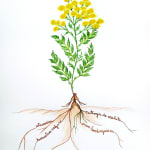Rosana Palazyan
sem título, da série Daninha? Qual é seu nome?, 2006-2012
aquarela e lápis de cor sobre papel
[watercolor and colored pencils on paper]
[watercolor and colored pencils on paper]
s/d
Copyright O Artista
A obra é uma ramificação da série Por que daninhas?, pesquisa desenvolvida desde 2006 pela artista, a partir de textos encontrados em livros de agronomia que tratam de estudos sobre...
A obra é uma ramificação da série Por que daninhas?, pesquisa desenvolvida desde 2006 pela artista, a partir de textos encontrados em livros de agronomia que tratam de estudos sobre plantas e definem o que são as plantas consideradas “daninhas”. As definições presentes nos livros revelam a nomeação de valores pejorativos e defeitos
dessas plantas. Ao confrontar tais análises, Rosana começou a questionar as terminologias e os argumentos que são historicamente utilizados no campo do tecido social, para caracterizar seres humanos que são considerados “indesejados”.
The work is an offshoot of the series Why weeds?, research developed since 2006 by the artist, based on texts found in agronomy books that deal with studies on plants and define what plants are considered “weeds”. The definitions present in the books reveal the naming of pejorative values and defects of these plants. When confronting such analyses, Rosana began to question the terminologies and arguments that are historically used in the field of the social fabric, to characterize human beings who are considered “unwanted”.
dessas plantas. Ao confrontar tais análises, Rosana começou a questionar as terminologias e os argumentos que são historicamente utilizados no campo do tecido social, para caracterizar seres humanos que são considerados “indesejados”.
The work is an offshoot of the series Why weeds?, research developed since 2006 by the artist, based on texts found in agronomy books that deal with studies on plants and define what plants are considered “weeds”. The definitions present in the books reveal the naming of pejorative values and defects of these plants. When confronting such analyses, Rosana began to question the terminologies and arguments that are historically used in the field of the social fabric, to characterize human beings who are considered “unwanted”.



